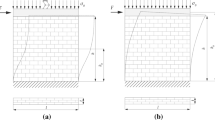Abstract
In this paper, numerical analysis of structural masonry subject to a uniform in-plane tensile stress/strain field is investigated employing various homogenisation techniques. Here, structural masonry is regarded as a composite material with brick, bed joints and head joints as its constituents. Assuming a perfect bonding between constituents. Assuming a perfect bonding between constituent materials, two homogenisation techniques based on the strain energy approach are applied to derive equivalent elastic moduli of masonry. Structural relationships for the constituent materials are next derived to relate strains and stresses in constituents to the average strains and stresses in the masonry. In addition, a slightly different concept of the homogenisation technique based on Eshelby's solution of the ellipsoidal inclusion problem is also applied to compare the results with the energy based methods.
The tensile strength of the masonry is found on the basis of the failure of any of the constituent materials. It is shown that tensile strength is a function of the elastic parameters of brick/mortar as well as the tensile strength of mortar. These studies also show that, although initial cracking occurs under horizontal tensile forces, the ultimate strength of the panel is higher in this direction than in the vertical direction.
Résumé
Dans cet article, on étudie l'analyse numérique d'une maçonnerie porteuse soumise à un champ uniforme et plan de contrainte de traction/déformation, au moyen de diverses techniques d'homogénéisation. On considère la maçonnerie porteuse comme étant un matériau composite ayant comme constituants des briques, des joints d'assise et des joints verticaux. En supposant une adhérence parfaite entre ces constituants, deux techniques d'homogénéisation basées sur l'approche de l'énergie de déformation sont appliquées afin d'en déduire les modules d'élasticité équivalents de la maçonnerie. Les relations structurelles pour les matériaux constituants sont ensuite déduites afin d'établir la relation entre les déformations et contraintes dans les constituants et les déformations et contraintes moyennes dans la maçonnerie. De plus, une conception légèrement différente de la technique d'homogénéisation, basée sur solution d'Eshelby au problème de l'inclusion ellipsoïdale, est appliquée afin de comparer les résultats avec des méthodes basées sur l'énergie.
On détermine la résistance à la traction de la maçonnerie sur la base de la rupture de n'importe lequel des matériaux constituants. On démonte que la résistance à la traction est fonction des paramètres élastiques briques/mortier, ainsi que de la résistance à la traction du mortier. Ces études montrent également que, bien que la fissuration initiale commence sous des forces de traction horizontales, la résistance ultime du panneau est supérieure dans le sens horizontal à celle dans le sens vertical.
Similar content being viewed by others
References
Pande, G. N., Kralj, B. and Middleton, J., ‘Analysis of the compressive strength of masonry given by the equationf k =K(f′ b )α(f′ m )β’The Structural Engineer 71 (1994) 7–12.
Zhao, Y. H. and Weng, G. J., ‘Effective elastic moduli of ribbon-reinforced composites’,J. Appl. Mech. 57 (1990) 158–167.
Hill, R., ‘Elastic properties of reinforced solids: some theoretical principles,J. Mech. Phys. Solids 11 (1963) 357–372.
Pietruszczak, S. and Niu, X., ‘A mathematical description of macroscopic behavior of brick masonry’,I. J. Solids Str. 29, (1992) 531–546.
Lourenço, P. B., ‘Computational strategies for masonry structures,’ PhD thesis, Dept. Civil Eng., Delft Univ. of Technology, The Netherlands, 1996.
Author information
Authors and Affiliations
Additional information
Editorial Note Prof. G. N. Pande is a Senior member of RILEM and Chairman of TC MMM (Computer Modelling of Mechanical Behaviour of Masonry Structures).
Rights and permissions
About this article
Cite this article
Lee, J.S., Pande, G.N. & Kralj, B. A comparative study on the approximate analysis of masonry structures. Mat. Struct. 31, 473–479 (1998). https://doi.org/10.1007/BF02480471
Received:
Accepted:
Issue Date:
DOI: https://doi.org/10.1007/BF02480471




